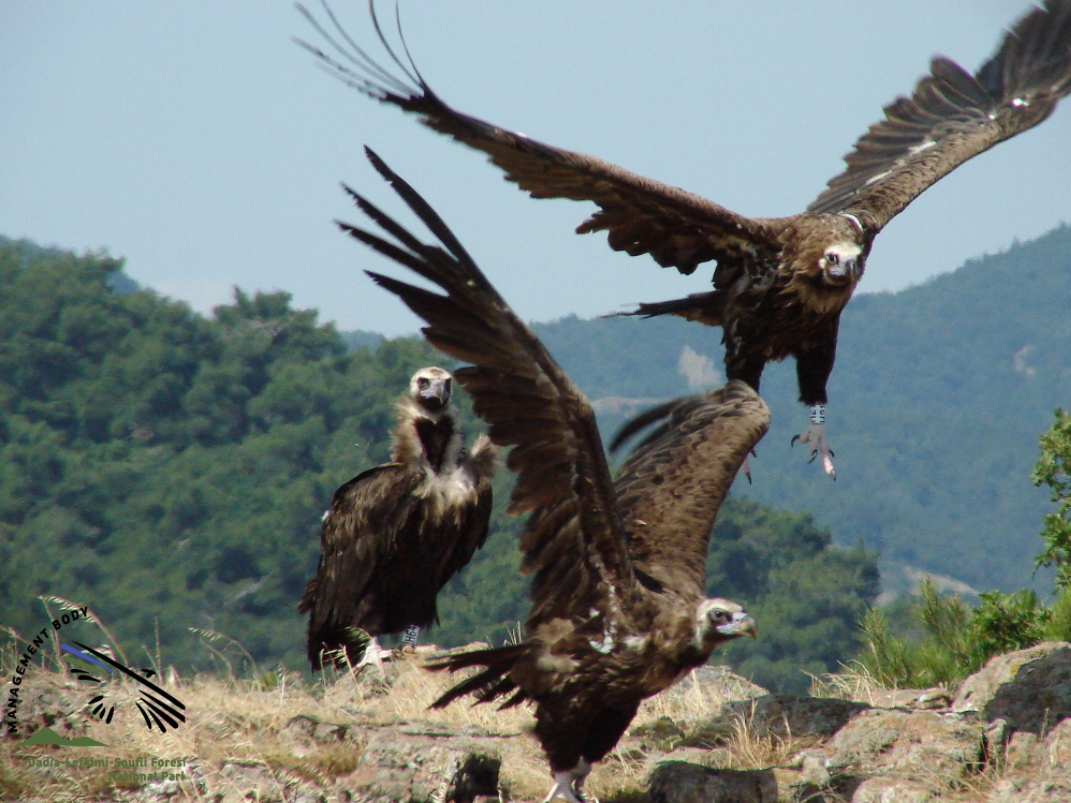Over the summer, one of the most important protected areas in Greece, the Dadia-Lefkimi-Soufli Forest National Park in the Evros Regional Unit (NE Greece), braved a huge wildfire, with 22,097 hectares of vegetation burned. At the time, the blaze threatened the security of important vulture colonies during a key period of their breeding season, which mobilized all the local authorities and conservation NGOs to take the necessary action to help preserve them. Now that a couple of months have passed, experts began their initial assessments regarding the extent of the fire’s damage and its impact on vultures.
A protected area of international importance under threat
There is no question that the Dadia-Lefkimi-Soufli Forest National Park is of great importance. Numerous flora and fauna species found in the Balkans, Europe and Asia coexist at the park. To be precise, its varied habitat supports 104 butterfly species, 13 amphibian species, 29 reptile species, 65 mammal species and 36 of Europe’s 38 bird of prey species.
When the massive fire started at the end of July, burning for days, it made the world fear a major ecological disaster. Hundreds of firefighters, volunteers and conservationists worked around the clock, doing their part to help save human property, protect nature and tend to the affected animals. The endangered vulture species that live there were among the animals that needed urgent attention at the time.
An important habitat for threatened vulture species
The Dadia-Lefkimi-Soufli Forest National Park is an ideal habitat for birds of prey and vultures. The park hosts three of Europe’s four vulture species – the Cinereous Vulture, the Egyptian Vulture, a globally endangered species, and the Griffon Vulture.
The park hosts 30 to 35 Cinereous Vulture pairs. It is home to the last (naturally) remaining breeding population of the species in the Balkans – several threats, such as poisoning, wiped out colonies in all the other Balkan regions during the 20th century. Although Cinereous Vultures are now breeding in Bulgaria again following the reintroduction project, the Dadia colony is key to the future of the species in southeastern Europe.


At the time of the fire, it was an extremely sensitive period for vulture breeding pairs. After months since the start of the long and demanding breeding season, their chicks were almost ready to take their first flights and leave the nest. But, the fire was approaching the colonies, threatening their survival. It was urgent to take action and prevent the worst.
Urgent action saves vultures from wildfire in Dadia
The mobilization was tremendous. The fire department, the Greek army, the Forestry Service and many volunteers did everything in their power to keep the blaze away from the vulture nesting grounds at the park while dealing with challenging terrain and unpredictable winds. Members from WWF Greece, the Society for the Protection of Biodiversity of Thrace (SPBT) and the Natural Environment and Climate Change Agency (NECCA) have also been at the forefront from the beginning, assisting the efforts to protect the vulture colonies.
WWF Greece, in collaboration with NECCA, under the coordination of the Ministry of Environment, retrieved two Egyptian Vulture chicks from their nest after the teams determined their survival was under threat. The chicks were kept in suitable facilities for eight days and then placed back in their nests when there was no fire risk. The field teams continued to monitor the situation to ensure their parents acted accordingly – thankfully, the chicks have now successfully fledged. This in itself was very interesting, as it provides evidence that wild Egyptian Vulture pairs immediately accepted back their chicks after an eight-day absence.

It was too risky to do the same for Cinereous Vulture chicks, both for the field teams and the chicks. Their nests were extremely difficult to reach and the chicks were quite big at the time, putting them at risk of trying to jump off their nests, which could result in serious injuries. So, they focused on keeping the fire out of the colony by building new firebreaks at its boundaries, which paid off in the end. Fortunately, the fire stopped outside the colony and the nests were not directly affected. Furthermore, it seems that the breeding success was also not affected since the adults continued to take care of the nestlings even when the fire was still burning. The field teams also provided supplementary feeding, during and after the fire, and the birds came to feed, even though the surrounding area was totally burnt. In the end, out of the 19 active Cinereous Vulture nests, all the chicks fledged, which is an excellent result, especially under these stressful circumstances.
Although it seems that the fire did not directly affect the breeding colonies of the vultures, the competent authorities will need to increase monitoring efforts during the next years, as many nesting trees for other important species were lost.
The VCF applauds everyone involved for their diligent efforts to contain the fire, keep the damage to a minimum and save the vulture chicks!
The rescue mission of the Egyptian Vulture chicks was implemented within the Egyptian Vulture New LIFE project.



